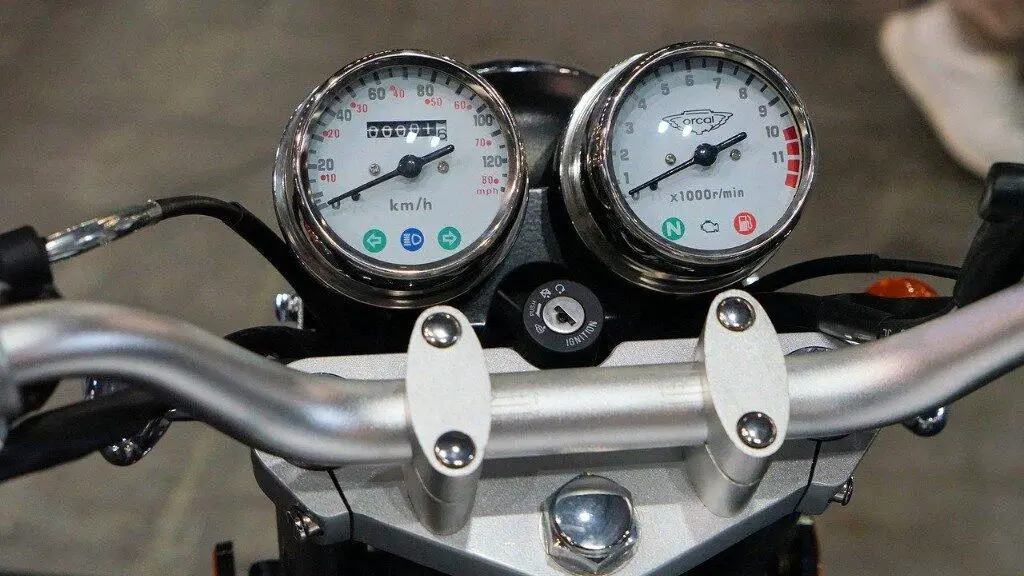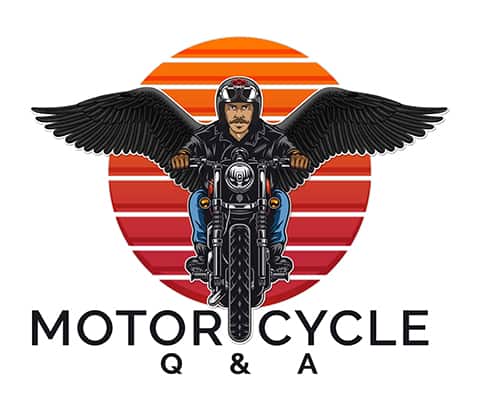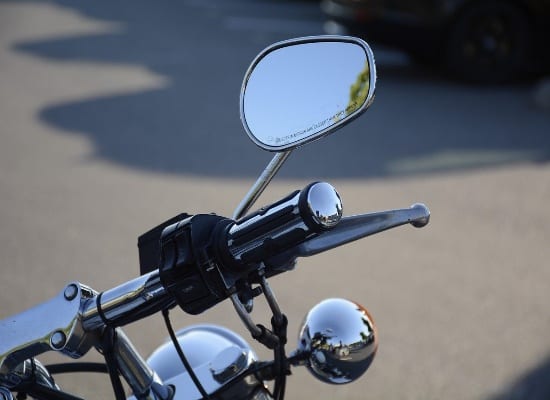
After reading this article, you will fully understand the pros and cons of adding a fuel gauge to a motorcycle.
I have included a handy gallon to mpg conversion table as well, which will give you the approximate mileage you can cover for your motorcycle tank size.
The sun is shining, and it a Saturday, so you decide to take your bike out for a ride. You put on your leathers and set off to your favorite coffee shop about 15 miles away.
Three-quarters of the way there, your bike’s engine starts to splutter, and you realize that you didn’t check how much fuel you had in the tank. Luckily you have a reserve, reach down, and twist the nob. There’s a garage about three miles down the road, so you ride to it and fill up.
I want to thank the sponsors of this post-EMANUALONLINE. Using their service, you can download your motorcycle or car manual to your mobile phone or any other device, so you will have it handy should you ever be out and about and need to use it. You can visit their website by clicking the icon below and use the code BUDDY15 to get a 15% discount.
This wouldn’t have happened if the bike was equipped with a fuel gauge. There are pros and cons of having a fuel gauge on a motorcycle, so here are 6 of them.
6 Cons Of Having A Fuel Gauge Fitted To A Motorcycle:
- A fuel gauge relies on a level senor, and motorcycles are rarely level
- A lack of space on the motorcycle to add a fuel gauge
- Possibility of leaking occurring when a fule gauge has been fitted
- A fuel gauge will not indicate the exact amount of fuel left in the tank
- Added fuel gauges can go wrong and give a false reading
- Cost of manufacturing a precise fuel gauge
6 Pros Of Having A Fuel Gauge Fitted To A Motorcycle:
- The fuel gauge should indicate the amount of fuel in the tank
- A nice looking fuel gauge can add to the character of the bike
- The bike may sell faster when a fuel gauge has been fitted
- Fitting the fuel gauge will give you another interesting project to complete
- Learning to read you fuel gauge correctly could save long walks to a garage
- If your motorcycle has no fuel indicator light, adding a fuel gauge would be a real benefit
I have listed 6 pros and 6 cons of adding a fuel gauge to a motorcycle. I will go into each one in more detail.
6 Cons Of Fitting A Fuel Gauge
- A fuel gauge relies on a level senor and motorcycles are rarely level
- A lack of space on the motorcycle to add a fuel gauge
- Possibility of leaking occurring when a fuel gauge has been fitted
- A fuel gauge will not indicate the exact amount of fuel left in the tank
- Added fuel gauges can go wrong and give a false reading
- Cost of manufacturing a precise fuel gauge
A fuel gauge relies on a level senor and motorcycles are rarely level
When was the last time your motorcycle was on completely level ground? Sure, when you have it parked on your driveway at home, the ground may be completely level, but when your out and about enjoying riding your bike and pull up, the ground is never completely level, right?
Fuel gauges rely on a level sensor for liquids, so it’s hard to get a precise reading from one if your motorcycle is not on solid ground that you know is exactly level. So 99% of the time, when you check the gauge, it will be a guesstimate of how much fuel is left in the tank.
A lack of space on the motorcycle to add a fuel gauge
A motorcycle has a lack of space to add items in the first place, so installing another instrument to it would definitely crowd up this precious space, especially if you would be thinking of adding a fuel gauge to a custom bike.
Thought would have to go into deciding if a fuel gauge was a real necessity or benefit. Maybe, it just adds style to the motorcycle. You may decide that other types of gauges would be more important to add.
However you look at it, space on a motorcycle is a premium and should be filled wisely.
Possibility of leaking occurring when a fuel gauge has been fitted
We all want our motorcycles to run, with the least amount of problems, right?
So yet another thing to bear in mind when thinking about adding a fuel gauge to a motorcycle is the possibility of something going wrong with how the gauge was fitted in the first place.
Now, bearing in mind that a regular fuel tank has two holes in it already, the whole where fuel is added to the tank and the hole where the fuel in the tank leaves to be used by the engine.
When adding a fuel gauge, another hole needs to be added to the tank, which may become corroded since fuel is a corrosive liquid.
Although this particular hole would be fitted with the fuel gauge and obviously have a seal fitted around the edge, it still adds to the chance of the seal failing and the area becoming corroded where the fuel gauge sits.
A fuel gauge will not indicate the exact amount of fuel left in the tank
When adding a fuel gauge to a motorcycle, the gauge will not show the exact amount of fuel left within the tank. Fuel gauges rely on a sensor that will operate the gauge’s indicator.
Motorcycle tanks are very individual to the type of motorcycle, and many have curves and grooves which hold fuel. When adding the fuel gauge, the sensor that comes with it will not measure the amount of fuel held within these grooves and give a false reading.
However, although this is listed under a con when the fuel indicator would show the tank is empty, there would still be fuel in the tank, just maybe not enough to get to a garage to fill up.
Added fuel gauges can go wrong and give a false reading
You’ve purchased your fuel gauge and installed it a couple of months ago. You decide to take your bike out for a ride and turn it on to allow it to warm up. While doing this, you check the fuel gauge, showing that the tank is half full. That’s plenty of fuel for the ride, so once the bike’s engine is warm, you set off to your destination.
Halfway to your destination, the revs on your bike start to drop, and the bike comes to a spluttery halt. You’re out of fuel!
One of the cons of installing a fuel gauge is that they can become faulty and start giving false readings. Once you become accustomed to just checking the fuel gauge indicator, you may not check inside the tank that often or notice the bike’s difference in weight.
You may become too confident in the reading an installed fuel gauge gives and may cause you to forget that at times, the gauge could give a false reading and leave you high and dry on the side of the road!
When adding a fuel gauge to a motorcycle, you should be aware that the technology is not perfect, and these gauges should be used as a general indicator and not a precise reading.
Cost of manufacturing a precise fuel gauge
Many new motorcycles now come with a fuel gauge built into the instrument panel. These fuel gauges are much better than they used to be back in the early days. However, although the technology has advanced in leap and bounds, it would still be extremely costly for manufacturers to design an absolutely precise fuel gauge. This cost would have to be passed onto the consumer.
The same would be the case for aftermarket fuel gauges. The cost of designing an aftermarket fuel gauge would outweigh the benefits the fuel gauge would give. Would anyone pay £500 or so for an aftermarket fuel gauge? I think not!
6 Pros Of Fitting A Fuel Guage
- The fuel gauge should indicate the amount of fuel in the tank.
- A nice looking fuel gauge can add to the character of the bike
- The bike may sell faster when a fuel gauge has been fitted
- Fitting the fuel gauge will give you another interesting project to complete
- Learning to read your fuel gauge correctly could save long walks to a garage
- If your motorcycle has no fuel indicator light, adding a fuel gauge would be a real benefit
The fuel gauge should indicate the amount of fuel in the tank.
If the fuel gauge is fitted correctly, it should indicate the amount of fuel that is in the fuel tank. If you know that the fuel gauge is not a precise measurement, it will help give you a rough indication of how much fuel is in the tank.
Using the fuel gauge in this way, you will not have to keep opening the fuel cap to check your fuel level or keeping track of your mileage so much. However, you will still have to be aware that these fuel gauges can go wrong.
A nice looking fuel gauge can add to the character of the bike
If you choose a good fuel gauge style, it can positively affect the look and character of the bike. There are many different fuel gauge designs on the market, so choosing one that complements your motorcycle shouldn’t be a problem.
Ensure that the one you choose has good positive reviews, and you have the space to fit it.
Aftermarket fuel gauges may come with instructions on how to fit them. However, some welding may be involved and cutting a hole in the tank where the gauge itself will sit.
If this is your preferred location, maybe a job left for a professional. Investigational work defiantly needs to be carried out before a fuel gauge is purchased to ensure that fitting one is viable for the type of motorcycle you own.
The bike may sell faster when a fuel gauge has been fitted
These days, many people who buy second-hand motorcycles see a fuel gauge as an added benefit to a motorcycle.
Obviously, this depends on the type of motorcycle being sold. For example, if you sell a custom-made motorcycle, a fuel gauge may not go with the bike’s persona and would sell faster without a fuel gauge.
However, if you are selling a bike as a general commuter, then a fuel gauge is usually a must for the new owner.
As the manufacturers of new motorcycles are including fuel gauges to their motorcycles more often than not now, having a fuel indicator is becoming more the norm. More and more people are expecting to see them fitted to a motorcycle.
If your motorcycle does not have a fuel level indicator, it may be why a prospective buyer will not purchase the bike from you. However, this may only be one reason they don’t go ahead and buy the bike.
Fitting the fuel gauge will give you another interesting project to complete
As well as enjoying actually riding your motorcycle out and about with your mates, one of the reasons we love our motorcycles is that it allows us to create projects to carry out on them.
Starting to investigate the types of fuel gauges available, which manufacturers are making the best ones, reading the reviews, watching videos, and subsequently purchasing a fuel gauge to install can be very interesting and fulfilling.
This is one of the great things about owning a motorcycle. Adding parts to and taking away from our motorcycles is all part of what the biking world is all about.
Also, installing a fuel gauge is a great way to know your bike further and gives you another project to carry out!
Learning to read you fuel gauge correctly could save long walks to a garage

You’ve installed your new fuel gauge to your motorcycle and have filled the tank up with petrol. The fuel gauge is reading full.
This, however, isn’t the end of the operation. Now, you will want to monitor how the fuel gauge is operating.
There are different ways to do this, I’m sure. However, one way would be to monitor the amount of fuel within your tank at the different gauge level indicators.
For example, when the gauge level indicator drops down one level, check to see how much fuel there is in the tank by taking off the fuel cap and looking.
Then carry out the same process every time the level indicator on the fuel gauge drops down one level until you can see how much petrol you have in the tank when the level indicator of the fuel gauge is at its lowest point as long as you are not going to run out of fuel at this stage.
By carrying out this simple process when looking at the fuel indicator the next time you are out enjoying a ride, you will know how much fuel you have left in the tank and will be able to fill up well in advance of the tank running dry.
Carrying out this check regularly will keep you checked with how the fuel level indicator is operating and should save you a possible long walk to a garage to buy some fuel.
If your motorcycle has no fuel indicator light, adding a fuel gauge would be a real benefit
When buying a modern motorcycle, many now come with a fuel gauge built into the dash. However, older bike models may have just been produced with a fuel light, which indicates when the level of petrol drops below a certain point.
These motorcycles would have been fitted with a reserve tank whereby you could twist a knob to allow the fuel to enter the engine from the 2nd tank space within the fuel tank and make your way to a garage to fill up.
But what about many of the custom-built motorcycles out there? The choppers or bobbers, for example. Many of these bikes would not have had a fuel gauge or fuel indicator light fitted unless the customer specifically asked for one to be included in the build.
Adding a fuel gauge to these bikes could be of real benefit to the owners, as the only way to check the amount of fuel is to open the petrol cap and look inside the tank and give it a shake. As long as there is room to fit the gauge, and it goes with the bike’s character!
How Do You Calculate Fuel Consumption On A Motorcycle?
You filled up with petrol and rode your motorcycle along the freeway to see a friend. However, your bike doesn’t have a fuel gauge, so you are unsure how much fuel your bike consumed on the way to your destination. So how would you know how much fuel you need to get back home?
Here is the answer:
You can calculate your fuel consumption easily, as long as you know your motorcycle’s average MPG usage and tank size. If your fuel consumption averages 55 mpg and you have a 4-gallon tank, then a full tank would cover 55 x 4 = 220 miles. If you travel 110 miles, you would have used 2 gallons of fuel.
This table calculates the distance a motorcycle could travel using its tank’s size and its average mpg. Assuming the tank is full.
Using the table, you can easily see the average distance your motorcycle can travel on a full tank of fuel.
Fuel Consumption Conversion Table
| Tank Size Listed Below | 35 mpg Average | 40 mpg Average | 45 mpg Average | 50 mpg Average | 55 mpg Average | 60 mpg Average |
| 1 gallon | 35 | 40 | 45 | 50 | 55 | 60 |
| 1.5 gallon | 52.5 | 60 | 67.5 | 75 | 82.5 | 90 |
| 2 gallons | 70 | 80 | 90 | 100 | 110 | 120 |
| 2.5 gallons | 87.5 | 100 | 112.5 | 125 | 137.5 | 150 |
| 3 gallons | 105 | 120 | 135 | 150 | 165 | 180 |
| 3.5 gallons | 122.5 | 140 | 157.5 | 175 | 192.5 | 210 |
| 4 gallons | 140 | 160 | 180 | 200 | 220 | 240 |
| 4.5 gallons | 157.5 | 180 | 202.5 | 225 | 247.5 | 270 |
| 5 gallons | 175 | 200 | 225 | 250 | 275 | 300 |
| 5.5 gallons | 192.5 | 220 | 247.5 | 275 | 302.5 | 330 |
| 6 gallons | 210 | 240 | 270 | 300 | 330 | 360 |
for example:
If your motorcycle has a 4-gallon tank and can travel at 45 mpg average consumption, then the bike’s total distance could travel on one full tank is 180 miles.
Gallon To Litre Conversion Table
| GALLONS | LITRES |
| 1 | 3.785 |
| 1.5 | 5.677 |
| 2 | 7.57 |
| 2.5 | 9.462 |
| 3 | 11.355 |
| 3.5 | 13.247 |
| 4 | 15.14 |
| 4.5 | 17.032 |
| 5 | 18.925 |
| 5.5 | 20.817 |
| 6 | 22.71 |
The Gallon To Litre conversion table easily allows you to convert your fuel tank’s size in gallons to liters or vice versa.






